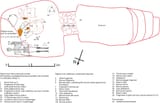Search Results
6/22/2025, 4:47:37 PM
>>63878953
Sorry for the confusion, I was speaking mostly to this distinction that a myceanean "naval" soldier wore different, special, lighter gear just because he expected to fight on ships, and that I think it his gear wouldn't have been too different from a regular, more land based soldiers-- and that because we don't have firsthand descriptions of either land or naval battles from this culture in this time period, we can't rule out anything.
And while Bell armour enjoyers would have almost certainly been chariot enthusiasts as well, being able to afford both, I would hesitate to just go ahead and call it mainly charioteer equipment for that same reason, even if it was likely-- its not like the bell armour is terrible for mobility on foot, at least according to the Greek marines who wore replicas, and we don't have depictions or descriptions of it being in particular use by charioteers in a way that indicates that it was especially necessary to use bell armour on a chariot, or that it was especially useful for a rider to have that extra protection-- I think it was more that if you could afford bell armour, you would have already been able to afford a decent chariot, and that you would opt to use them together where and when you could, given how useful both would be on the battlefield, and would therefore use them together. But anything on this, without a reliable historical source, is just speculation-- even in archeology, where we do have fragments of bell armour as funerary deposits, its not always, or even often accompanied by a chariot or chariot gear-- not that the presence of two things as grave goods means they were always used together, or vice versa of course, but we really just don't have enough information on warfare from that time to know.
What we really need to do is to get a bunch of guys in that armor on chariots and run them through a variety of test to get any insight into this
Pic related is Dendra tomb,
Sorry for the confusion, I was speaking mostly to this distinction that a myceanean "naval" soldier wore different, special, lighter gear just because he expected to fight on ships, and that I think it his gear wouldn't have been too different from a regular, more land based soldiers-- and that because we don't have firsthand descriptions of either land or naval battles from this culture in this time period, we can't rule out anything.
And while Bell armour enjoyers would have almost certainly been chariot enthusiasts as well, being able to afford both, I would hesitate to just go ahead and call it mainly charioteer equipment for that same reason, even if it was likely-- its not like the bell armour is terrible for mobility on foot, at least according to the Greek marines who wore replicas, and we don't have depictions or descriptions of it being in particular use by charioteers in a way that indicates that it was especially necessary to use bell armour on a chariot, or that it was especially useful for a rider to have that extra protection-- I think it was more that if you could afford bell armour, you would have already been able to afford a decent chariot, and that you would opt to use them together where and when you could, given how useful both would be on the battlefield, and would therefore use them together. But anything on this, without a reliable historical source, is just speculation-- even in archeology, where we do have fragments of bell armour as funerary deposits, its not always, or even often accompanied by a chariot or chariot gear-- not that the presence of two things as grave goods means they were always used together, or vice versa of course, but we really just don't have enough information on warfare from that time to know.
What we really need to do is to get a bunch of guys in that armor on chariots and run them through a variety of test to get any insight into this
Pic related is Dendra tomb,
Page 1
